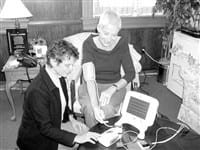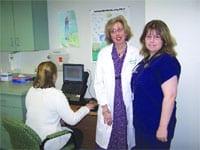Remote Control Holyoke VNA Unveils New Web-based Remote Monitoring Equipment For Patients
‘Telemedicine’ sounds like the stuff of science fiction novels. But it’s real – and it’s working to improve the lives of Western Mass. residents right from their living rooms.
Telemedicine, or telemonitoring, is the use of electronic monitoring systems by individuals living with or recovering from medical conditions at home. The systems create a connection between patients, caregivers, physicians, and other involved parties such as visiting nurse associations or hospice providers, to offer more complete care to patients between scheduled visits to the hospital or doctor’s office.
The technology is still new, but gaining popularity across the country as an answer to costly emergency room visits by home care patients and a persistent nursing shortage, which precludes many nurses affiliated with VNAs and other organizations from making frequent unscheduled visits to check on home-bound patients.
After seeing the success of telemonitoring units in other parts of the country, the Holyoke VNA set out to research and acquire the technology for its own patients.
The organization ultimately purchased 10 ‘Remote Nurse’ units, funded in part by grants from Peoples Bank and the Community Foundation, that will be placed in patient’s homes in coming months to assist with patient monitoring. The Holyoke VNA is the first group of its kind in Western Mass. to add telemedicine to its list of regular services.
Popular Science
After some basic training, patients can use the new units to check basic vital signs and statistics themselves, based on a care plan set out by the patient’s physician. The systems, made by Web VMC (Virtual Medical Care) in Georgia, are Web-based and allow patients or their caregivers to take daily measurements of blood pressure, glucose levels, weight, or other variables, and send the results electronically to a plotting system that creates detailed reports and graphs for a physician to review.
Because the units are Web-based, readings are accessible through a password-protected system via the Internet, so VNA nurses or anyone else the patient has authorized can view the daily results and remain aware of any dangerous changes or trends. A patient who must remain below or above a certain weight, for example, can be alerted to any changes in weight before unsafe levels are reached. The entire system is also HIPAA compliant, in relation to privacy and security.
Patricia Cavanaugh, vice president of Home Care and Hospice Services at the Holyoke VNA, added that there are a few telemonitoring systems on the market, but Web VMC is simpler to use than some of the alternatives (the units require only a phone jack and an electrical outlet to complete all functions), and also allows family members to be part of the monitoring process. She said both aspects were key in choosing a telemonitoring company with which to work.
“The complexity of the systems was a major concern,” she said, “and the fact that this is Web-based was a big plus for us. Some of the systems use a central monitoring station … the Web-based model eliminates that ‘middle-man’ and allows family members to be more involved. That’s important to a son or daughter who may not live close by, but wants to be involved with their parent’s health.”
Increased involvement in patient care at all levels, from family to physician, is another benefit of the Remote Nurse units. Linda Forsman, vice president of Marketing and Contracting at the Holyoke VNA, said the telemonitoring systems will help create a more complete picture of a patient’s condition, and can also alert physicians to developing problems. VNA clients with cardiac or respiratory problems, diabetes, hypertension or obesity can all benefit from telemonitoring, as well as patients with congestive heart failure, which has become the VNA’s target audience for the new technology. The ultimate goals for all patients, Forsman said, are to cut down on hospital admissions and unscheduled VNA nurse visits, and improve the overall quality of life.
Virtual Care
Two of the units are currently in use in patients’ homes, and the VNA is working with area physicians and hospitals to coordinate the use of additional units in households. Although the equipment does not replace a visit from a VNA nurse, Forsman said that adding it to the VNA’s suite of services is a huge step toward providing a greater quality of care to clients.
“Quality of life is so important,” she said. “And that quality diminishes when constant visits to the emergency room, doctor’s office, or admissions to the hospital are necessary. Many emergencies are indicated before they become an emergency, and this system allows us to focus on prevention and early detection.”
“Physicians love it,” Forsman continued. “They can go into the system seven days a week if they want, and pull up information on a patient. From a case-management standpoint, it lets doctors see the big picture, and ultimately we expect it will improve outcomes.”
The telemonitoring systems can also be modified to perform detailed functions for physicians; they can be paired with a digital camera so doctors can monitor wound dressings remotely, for instance, or used with peak-flow meters, which allow respiratory patients to measure peak expiratory flow each day, and can pick up on trends that indicate possible severe attacks.
The technology can be daunting for many, especially elders, but with telemedicine as part of regular VNA services, patients have access to a network of trained nurses to assist them. Forsman noted that patients who choose to remain in their homes also have remarkable ability to adapt to their specific medical situation.
“In some cases, we’re working with elders who have never even worked a microwave,” she said. “But people do amazing things. They learn to work IV pumps, to dress wounds, to draw blood…they try so hard to follow doctor’s orders and people are so motivated to keep themselves healthy.”
Winning Technology
Forsman said it has been exciting for patients, physicians and VNA staff alike to watch the new program take off. The organization is now introducing the technology to hospitals, assisted living facilities, private physicians and other facilities that have yet to sign on with the telemonitoring program in Hampden and Hampshire County, in hopes of expanding the service across the region.
“Everyone seems to be excited about it,” she said. “They see what we see – that there isn’t a down side. It’s a valuable service, it is cost-effective, and it improves quality of care. It’s a win-win-win.”


